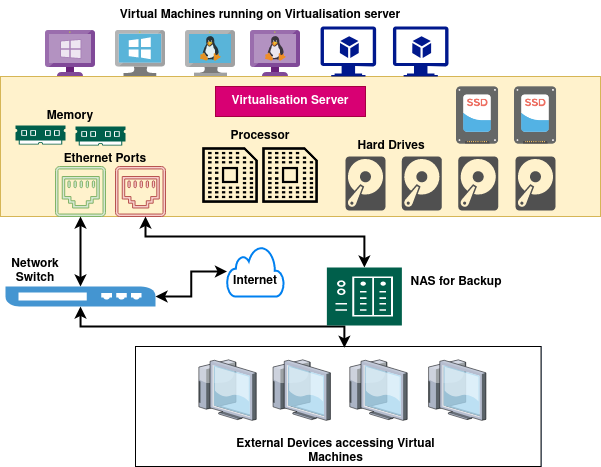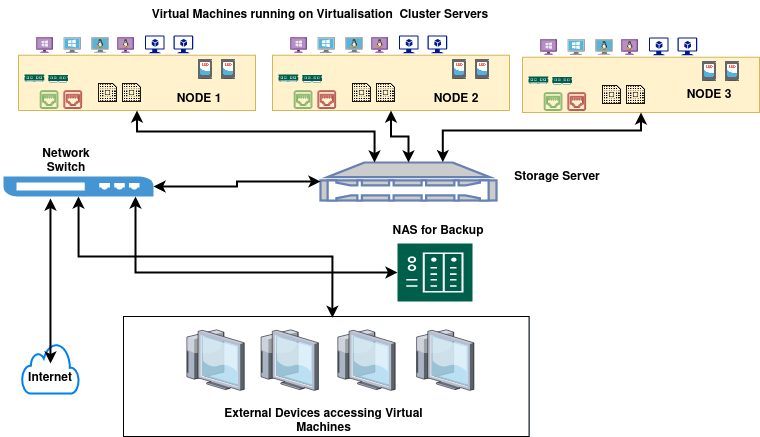Computing Products
Virtualisation : Standalone Server

Standalone Virtulisation Server
In this type of Virtulisation, local storage is used. Has all the required features.
Very useful to small office or where number of VM’s are limited. [ Limited only by host Processor’s cores / Ram ]
Required Minimum Hardware : Intel / AMD Multicore 64 Bit Processor supporting VTX , VTD / Memory – 16 GB Onwards, Boot SSD Drive, & couple of Harddrives of same size, Ethernet Interfaces – 2 – Can be in Rack Mounted or Tower type Server.
However, external NAS is suggested for automated backup. No support for Live Migation or Fail-over as simply because no additional nods ar available.
Virtualisation : Cluster Mode

Cluster Mode Virtulisation
Most suggested way of Virtualisation Mode as one can get full benefits of features like, Live Migration, Fail over for running VM etc. Best for running critical VM requiring 24X7 operations.
Required Minimum Hardware : Intel / AMD Multicore 64 Bit Processor supporting VTX , VTD / Memory – 16 GB Onwards, Boot SSD Drive, Ethernet Interfaces – 2 – Can be in Rack Mounted or Tower type Server. – Qty – atleast 3 numbers ( suggested 4 ) to form a cluster with a centralised storage server. Supports upto 32 nodes.
An external NAS is suggested for automated backup.
Virtualisation : Hyper Converged Server

Hyper Converged Server
This is a special type of virtulisation [ All-In-One ] server. It consists of advanced storage [ local ], separate firewall service.
Very useful to small offices where the space is limited, but data or VM’s are critical.
Required Minimum Hardware : Intel / AMD Multicore 64 Bit Processor supporting VTX , VTD / Memory – 32 GB Onwards, Boot SSD Drive, & couple of Harddrives of same size, Ethernet Interfaces – 2 – Can be in Rack Mounted or Tower type Server.
TECHNOLOGY UNFOLDED
| Feature | Vmware | Hyper-V | Open Source Virtulisation | Remarks - for Open source Virtulisation |
|---|---|---|---|---|
| License Type | Proprietary license | Proprietary license | Open source license | No vendor Lockin |
| Basis | VMkernel | Windows Server | Linux KVM | |
| VM Creation, Deletion, Snapshots, VM templates, cloning, export/import, and replication | Yes | Yes | Yes | AT Par with competition |
| Guest OS Support | Windows/Linux/ Mac OS | Windows / Linux | Windows/Linux/BSD/ Solaris/ Mac OS | AT Par with competition |
| Central Management | Yes | Yes | Yes | AT Par with competition |
| Clustering | Yes | Yes | Yes | AT Par with competition |
| High Availability | Yes | Yes | Yes | AT Par with competition |
| Storage and Backup API | Yes | Yes | Yes | AT Par with competition |
| Live Migrations of VMs | Yes | Yes | Yes | AT Par with competition |
| Load Balancing of VMs | Yes | Yes | Yes | AT Par with competition |
| vCPU Limit Per VM | 128 | 64 | 160 | AT Par with competition |
| Logical CPU limit | 768 | 512 | 768 | AT Par with competition |
| Physical Memory Limit | 24 TB | 24 TB | 12 TB | Practically difficult to reach this kind of memory per host. , Hence the feature is less important |
| Node Limit Per Cluster | 64 | 64 | 32 | Practically difficult to reach this kind of memory per host. , Hence the feature is less important |
| VMs per host | 1024 | 1024 | No Limits | Better than competition but Practically difficult to reach this kind of memory per host. , Hence the feature is less important |
| Scheduled Backup | Yes, requires third party or expensive additional components | Yes, requires third party or expensive additional components | Yes | |
| Nested Virtulisation Support | Yes | Yes | Yes | |
| Ease of Use | Require expirtise | Require Expertise | Very Easy to use. | |
| Container support | yes | Yes, Inbuilt | ||
| Inbuilt scheduled backup | No | No | Yes | No additional costs. |
| Firewall - | Yes but costs $4,995/Year | Windows type firewall | Yes @ no extra costs. | |
| Hardware Compatibility | Requires Certified Hardware | Requires Certified Hardware | Wide range of Hardware | |
| Network Storage Options | Limited | Limited | Wide range including iSCSI, LVM, GlusterFS, CIFS, ZFS, and CephFS | |
| Passthru Hardware` | Yes | Yes, but tedious process | Yes | |
| Onsite Support / Installation | NO | No | Yes | |
| License Cost | Essential - $577 , Standard $1,394, Enterprise $4,780 Essential Plus Kit $5,596 | Basic - €295 per year and CPU socket, €445 per year and CPU socket, €890 per year and CPU socket | Nil | |
| Implementation Charges | Yes | Yes | Yes. |
What is virtualisation ?
Virtualization creates an abstraction layer over physical computer hardware that allows processors, memory, storage, etc., to be divided into a series of virtual machines (VMs). Each VM runs its own operating system (OS) and in essence, behaves like an independent computer, although it is basically running on a fraction of the actual underlying computer hardware.
This process promotes the efficiency of resource utilization and allows a greater return on an enterprise’s hardware investment. The technology drives cloud computing economics and is a standard practice in enterprise information technology (IT) architecture.
Benefits of virtualization
Here are the benefits of virtualization software:
- Promotes efficient utilization of computer hardware resources and helps slash your IT expenses.
- A virtualized environment enhances resiliency and reduces downtime.
- Helps increase the speed of development and operations without impacting a production environment, as you can clone a VM for development/testing.
GANSAN implementation of Virtualization is an enterprise level virtualization solution that supports crucial virtualization workloads, including critical and resource-intensive applications. The platform is built on Kernel-based Virtual Machine (KVM).
Using the virtualization , you can virtualize both Linux and Windows workloads for improved performance. The solution can be used to containerize VMs as well. The Linux-based virtualization system is open-source and is ideal for IT departments and owners alike since on the one side it reduces management headaches and other side cost too.
Data Sheet : GANSAN Implementation
| Feature | Details |
|---|---|
| Virtulisation Type | Bare Metal using KVM - TYPE-1 |
| Architecture | 64 Bit X86 |
| Max Ram / CPU per host | Supports upto 12 TB Ram / 768 vcpu per host |
| HA Capable, Live Migration | Yes, in cluster mode |
| VM -Templates, Snapshots, Clone, Import & Export | Yes |
| Full VM Backup / Restore | Yes. |
| Web UI for easy management | Full featured Web UI |
| Guest OS compatibility | Windows Desktop : Windows 7, Windows 10 Windows Server: 2008, 2012,2016,2019,2022 editions Linux : All mainstream BSD : Almost all |
| Containers | Yes |
| Storage | Local + Remote over Ethernet |
| Storage File System Support | ZFS, NFS, iSCSI, CIFS |
| Networking | Bridge [ In-Built], OVS |
| Firewall | Easy Firewall |
| Security | User / Groups / 2FactorAuthentication |
| License cost | Nil [ Open Source ]. We charge for design, installation and implementation only. |
| Support | On-Site Installation / Remote support thru ticket portal. |
| Implementation Time | Depending on Sizing. ( 1 to 3 days approx ) |
Note : Due to continious changes in technology, all features are subject to change. Please check with GANSAN at the time of placing the order.
FAQ - On Virtulisation
We normally use Kernel-based virtual machines (KVM) simply because, in our view, it performs better, and very stable. Since it is Open Source, its frequently updated for new hardware as well security patches.
Main Benefits :
- Performance – One of the main drawbacks of traditional virtualisation technologies is performance degradation compared to physical machines. Since KVM is the type-1 hypervisor, it outperforms all type-2 hypervisors, ensuring near-metal performance. With KVM hypervisor VMs boot fast and achieve desired performance results.
- Scalability – As a Linux kernel module, the KVM hypervisor automatically scales to respond to heavy loads once the number of VMs increases. The KVM hypervisor also enables clustering for thousands of nodes, laying the foundations for cloud infrastructure implementation.
- Security – Since KVM is part of the Linux kernel source code, it benefits from the world’s biggest open source community collaboration, rigorous development and testing process as well as continuous security patching.
- Maturity – KVM was first created in 2006 and has continued to be actively developed since then. It is a 16-year old project, presenting a high level of maturity. More than 1,000 developers around the world have contributed to KVM code. Even major cloud platforms and fortune 500 companies also use KVM.
- Cost-efficiency – Last but not least, the cost is a driving factor for many organisations. Since KVM is open source and it comes at zero cost. However, we do tweak again to get most out of it.
Our implementation comes with a Web Interface. So managing is simple, and all you require to manage is a modern web browser like Chrome, Firefox or Edge.
At the time of deployment, we will be able to offer administrative training. Since its a very user friendly environment, even any average user will able to master it within no time.
Windows based VM – You can connect using RDP from your Desktop / Laptop or Thin client.
For Linux VM, You can connect using RDP or SSH client based on distribution.
Demo can be arranged. Please create a Demo Request on https://ticket.gansanit.com. Alternatively you can talk to GANSAN team. [ check contact page for tele numbers ]
Yes in most of the cases. Please check with GANSAN technical team on this.
Our implementation supports template creation. Once the template is available, it takes less than 2 minutes to create a new Virtual Machine with the operating system and application – ready to use.
Go for a Cluster deployment. You will get what you need.
| Sr. | VM Role | Operating System / Version/ Major Applications | Cores | Memory | Storage |
|---|---|---|---|---|---|
| 1 | |||||
| 2 | |||||
| 3 | |||||
| 4 | |||||
| 5 |
